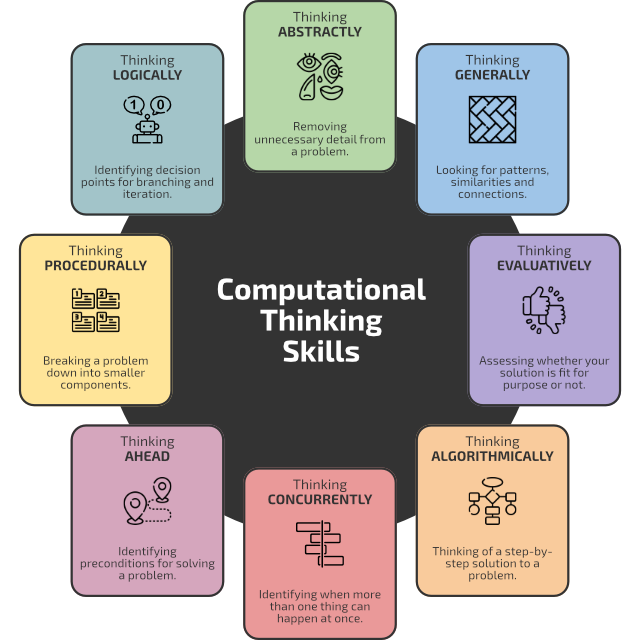ct - computational thinking
The eight features of a computational thinker/problem solver.
Computational Thinking
title | desc |
|---|---|
| Thinking abstractly | Removing unnecessary detail from a problem to make it more straighforward to solve. |
| Thinking generally | Looking for patterns and connections between problems. |
| Thinking evaluatively | Assessing whether your solution is fit for purpose. |
| Thinking algorithmically | Thinking of a step by step solution to a problem |
| Thinking concurrently | More than one thing happening at a time |
| Thinking ahead | Identifying preconditions of a problem |
| Thinking procedurally | Breaking down a problem into smaller components |
| Thinking logically | Identifying decision points for branching and iteration |
| Thinking recursively | Looking for re-entrant similarities in a problem |
In the world of (mostly) solvable problems in which we live, therein lies some basic strategies in which the logical/computational thinker can approach a strategy for a potential solution. Traditionally, the four core skills of Computational Thinking (CT) are:
Thinking PROCEDURALLY (commonly known as decomposition)
Thinking GENERALLY (pattern recognition)
Thinking ABSTRACTLY (pattern generalisation)
Thinking ALGORITHMICALLY (algorithm design)
...plus, I like to extend these skills to cover the following:
Thinking EVALUATIVELY
Thinking CONCURRENTLY
Thinking AHEAD
Thinking LOGICALLY
..and additionally (particularly for IB CS):
Thinking RECURSIVELY
Though these skills have been recognised within problem solvers since problems existed to be solved, the term Computational Thinking was coined by one Seymour Papert (the inventor of Logo) in 1980 in a book called 'Mindstorms' (a name which may be familiar to lovers of Lego).
“Computational Thinking is borne out of curiosity.
It is difficult to teach. Our role as educators is to provide the
framework to facilitate its development.”
Mark Mills 2016
It is difficult to teach. Our role as educators is to provide the
framework to facilitate its development.”
Mark Mills 2016

Computational Thinking Skills
More recently, one of the most well-known protagonists of CT has been Jeanette Wing formally of Microsoft Research, expressing the algorithmic problem-solving and abstraction techniques used by computer scientists and how they might be applied in other disciplines.
Free for your classroom!
Here is a free set of posters outlining the basic skills involved in CT for your classroom or lab. They are A4 in size but can be blown up onto A3 should you require it! It's a pleasure 😃
YouTube Playlist
YouTube Video
In this playlist, I have compiled some notable YouTube videos which demonstrate some of the ideas in CT. I don't think that the audience for these is necessarily students but they may provide some insight into the mind of the logical problem solver.
WWW Links
🌐
en.wikipedia.org
In education, computational thinking (CT) is a set of problem-solving methods that involve expressing problems and their solutions in ways that a computer could also execute.
🌐
en.wikipedia.org
Jeannette Marie Wing is Avanessians Director of the Data Science Institute at Columbia University, where she is also a professor of computer science.
🌐
en.wikipedia.org
Logo is an educational programming language, designed in 1967 by Wally Feurzeig, Seymour Papert, and Cynthia Solomon.
🌐
mindstorms.media.mit.edu
Seymour Papert’s Mindstorms was published by Basic Books in 1980, and outlines his vision of children using computers as instruments for learning.
🌐
en.wikipedia.org
Seymour Aubrey Papert was a South African-born American mathematician, computer scientist, and educator, who spent most of his career teaching and researching at MIT.
Last modified: July 12th, 2023






















